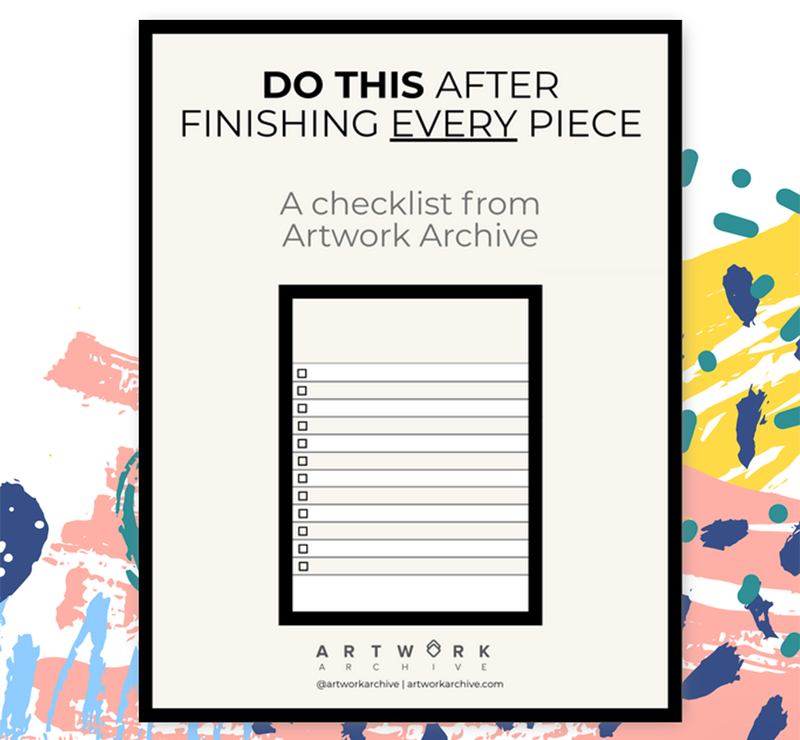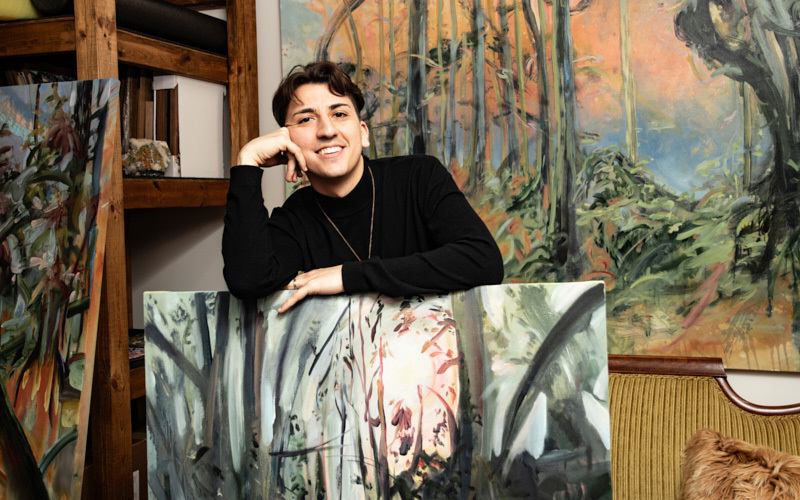 Artist Thomas Flynn II faced what he calls an "existential threat." He turned it into new creativity.
Artist Thomas Flynn II faced what he calls an "existential threat." He turned it into new creativity.
“I try to capture images that make me dream, that transport my mind somewhere beyond what’s right in front of me. Whether that be the light coming through the trees, or the way my daughter’s hair falls, or an interesting shaped log seen on a walk with my dog.”
Those fleeting, tender, and often overlooked everyday moments are what anchor Thomas Flynn II’s work. A painter living in Atlanta, GA, this week’s Featured Artist builds his practice around the forests of the Southeast, exploring the mystical and emotional presence of the landscape around him.
Working between studio and plein air settings, Thomas's layered, gestural approach reflects his deep connection to the land and an evolving dialogue with the natural world. As he mixes clay into pigment, lets wood panels and torn canvas edges echo the land’s textures, and traces light as it bends through branches, each piece emerges as an active interaction with the natural world.
“The forest is forever because it dies and dies and so lives,” Thomas reflects. That cyclical rhythm of mortality and renewal, paired with an almost anthropomorphic view of nature, shapes a body of work drenched in color and alive with shifting silhouettes.
Read on to learn more of Thomas’s insights, process, and practice from his in-depth conversation with Artwork Archive.
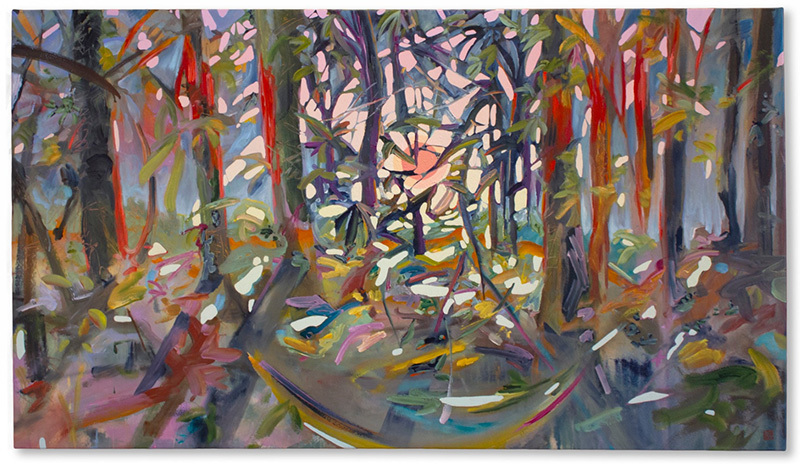 Thomas Flynn II, Warmth of the Winter Sun, 2023, acrylic on canvas, 40 x 70 x 1.5 in
Thomas Flynn II, Warmth of the Winter Sun, 2023, acrylic on canvas, 40 x 70 x 1.5 in
How to Create Your Own Artist Residency
The year was 2022, and Thomas was feeling anxious. Artificial Intelligence had suddenly advanced to the point that it could generate passable illustrations with the right prompts. Sure, the AI models were still glitchy and would make plenty of mistakes, but Thomas felt these tools still represented the “existential threat of outsourcing human creativity.”
"I wanted to create paintings inspired by the undercurrent of wonder inherent to the landscape,” Thomas recalls—something “that goes beyond ‘generate an abstract painted forest scene inspired by rural Georgia.’” He needed something that could put him firmly in the messy, unruly reality of nature, with all its scents, textures, and sensations.
So, he took a drastic step: “I went on a self-imposed five-day residency in the backwoods of Georgia.” He carried his painting supplies out into the woods, and started making work directly inspired by what he saw right in front of him. These are works shaped by the specificity of the region he calls home, but filtered through his own experiences and the undercurrent of magic that he feels coming from these places.
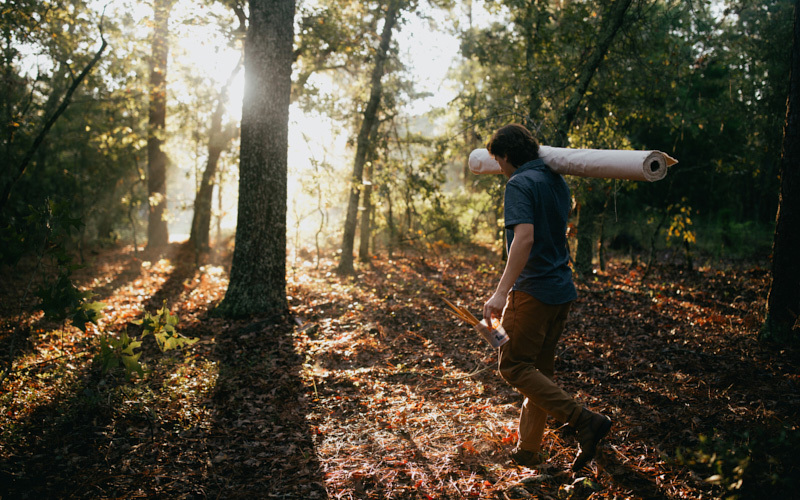 When he couldn't find the residency he wanted, Thomas created his own.
When he couldn't find the residency he wanted, Thomas created his own.
The Painter of Natural Life
His first step in his new painting journey was to pay close and calm attention to the life of the forest. “I wanted to find the bits of light that reflected and refracted off of every droplet that fed the fern that became a den,” he remembers. “I wanted to find the parts of myself that are beneath the surface but reflected in the landscape. Like looking around you as if through water, looking through a portal into what’s possible for yourself and for the world.”
Thomas was often surprised at what he found in the landscapes. It was as if he had come with preconceptions about what these forests and woodlands looked like, but by simply sitting and waiting quietly, they would begin unveil something new to him on each visit.
The project grew from there: “I then ended up traveling, camping, and painting all throughout the Southeastern United States between Texas and Georgia to further create the series and explore the concept,” he recounts.
It can be hard for artists to find a central theme—or even a sustainable pace—for their work. But from Thomas's process, the core of his practice slowly emerged on these trips. These hikes into nature created the “start to the trail of thoughts that form the backbone of my current work,” he reveals.
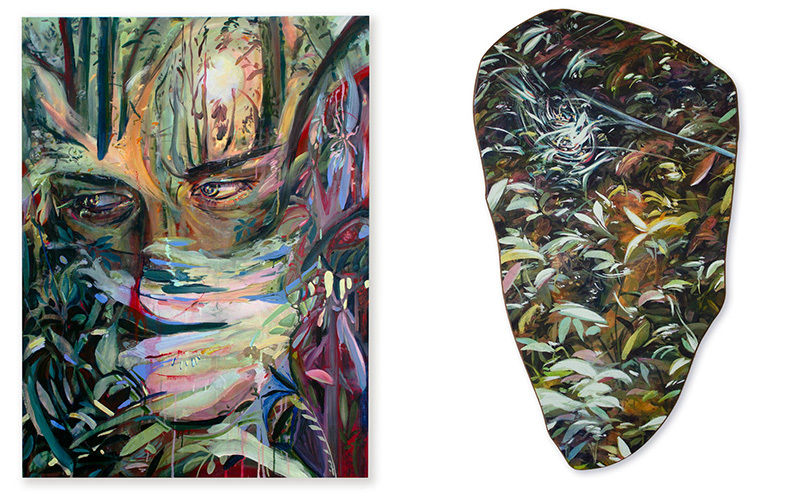 Thomas Flynn II, Contending with the landscape of myself, 2025, acrylic on canvas, 48 x 36 in, and I saw the web of life and death at 3:42 PM, 2024, acrylic on canvas mounted on shaped panel, 33 x 18.5 x 1 in
Thomas Flynn II, Contending with the landscape of myself, 2025, acrylic on canvas, 48 x 36 in, and I saw the web of life and death at 3:42 PM, 2024, acrylic on canvas mounted on shaped panel, 33 x 18.5 x 1 in
Learn to Take Your Art Career Seriously
Now that Thomas had an exciting idea animating his practice, he had to figure out how to make time to create his paintings.
“It is my belief that art takes up the space in your life that you allow it to,” he tells Artwork Archive. And for Thomas, he wasn’t giving art enough time.
“When I first started taking my art career seriously, I had to shed years of self-doubt and limiting beliefs to accommodate what I believed people wanted to see in me or my work,” he admits.
The first thing he needed to do was change his mindset. “Things started going better for me when I stopped waiting for someone to ‘pick me,’” he recalls with excitement. “Pick me for their show, for their gallery, for their residency.”
Instead, he embraced the power he already had: “The mindset shift is rewriting the narrative from ‘Once I get XYZ, THEN I’ll be able to create, then I’ll be able to support myself, then I’ll be able to make what I want to make,’ and changing it to, ‘I am creating. I am supporting myself. I am making what I want.’”
Thomas is very grateful to those who have chosen to support him. “I’m where I am today because so many collectors, curators, and gallerists have decided to take a risk on my work and supported my vision,” he offers.
And yet, to get there, he had to choose himself first, and invest in professional tools like Artwork Archive to make his artist journey possible: “I am the one who chose to pursue this path and I choose to continue it every day and with each step forward.”
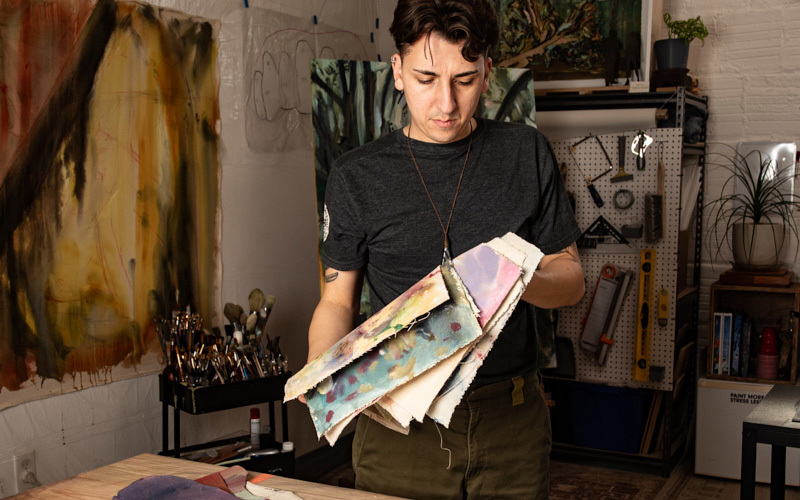 Don't wait for someone else to give you permission to be an artist—only you get to make that decision.
Don't wait for someone else to give you permission to be an artist—only you get to make that decision.
Creating the Art That AI Can’t
These days, Thomas’s very human art begins with his experience of the way light and experience conspire to create something special. “The magical is embedded inside of the ordinary and is begging to be seen and cherished,” he tells Artwork Archive.
“In the studio,” he says, “I like to start by ‘messing up’ the surface of the canvas as quickly as possible.” This prevents him from getting too invested in any perfect outcome he might have had at the outset, allowing the painting to come alive through the process.
Then he starts to build up layers of paint to render forms and sun-dappled foliage. “I work almost exclusively in acrylic, but I often work very ‘wet on wet’ so the paint is allowed to blend and mix almost alchemically,” he shares. “I welcome the messy beauty in my work and often will keep some of these first layers somewhat visible in the final piece.”
He lays down paint fairly quickly, but the final artwork might take longer to reveal itself. Through layers added over multiple sittings, and tweaks to heighten a certain feeling in the surface of the canvas, the painting starts to reveal itself.
AI has come a long way since 2022, but the consideration, judgment, and human experience that Thomas brings to his canvases are still something that AI cannot invent.
Thomas has a simple way to tell when a piece is ready. “When the piece becomes bigger than the idea, full to bursting, I stop,” he explains. “The piece is finished when I can see an element of the magical shining through the work.”
12 Things Every Artist Should Do After Finishing Any Piece
You've put the final touches on your painting, you've fired your ceramic piece, or you've printed your photograph—what now? Check out Artwork Archive's 12-point guide for the steps you should take after finishing any piece.
Making Art Your Fulltime Passion
Even with his new, empowered mindset, Thomas says it took him about a year “to feel even somewhat comfortable calling myself an artist.”
“Before I became a fulltime artist, I was making about four or five paintings a year, just kind of weekend warrior-ing it,” he remembers.
He could keep track of that number of paintings in a Word document, but when he started to ramp up his production, he quickly ran into major problems: “Once I dedicated myself to making art as a living, I made almost 100 pieces that first year and was quickly unable to stay organized on the information about each of them—nevermind which shows they were in and who bought them.
That’s when he found a solution that could match his aspirations of having a full-time, sustainable art career. “Artwork Archive was a lifesaver and made tracking information about each artwork so easy,” he shares. “I have been recommending the platform to other artists for years. I honestly have no idea how I would run a studio without it.”
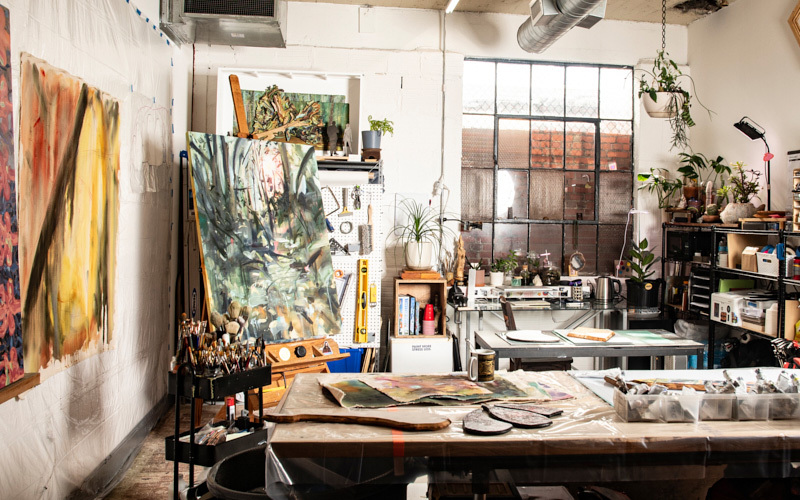 Thomas uses Artwork Archive to keep his studio organized and sustainable.
Thomas uses Artwork Archive to keep his studio organized and sustainable.
Use Professional Art Tools for Professional Artists
Apart from using it keeping track of his now-prodigous output of paintings, Thomas has come to rely on so many of Artwork Archive’s tools.
“I love love love how easy creating PDFs to send to clients, gallerists, and curators is in Artwork Archive,” he says. “I print out reports to deliver with pieces to shows, to send options to clients, and to mark packaged artwork in my studio.”
As an exhibiting artist, he has also come to rely on features that make it easy to know where his art is at any given time: “I also love the locations/exhibitions feature,” he adds, “it really makes it easy to reference exhibition contract highlights and see the provenance of a piece.” If you’ve ever found yourself losing track of all the consignment reports, exhibition agreeements, and other important legal documents that come with showing and selling your work, you know what Thomas is talking about.
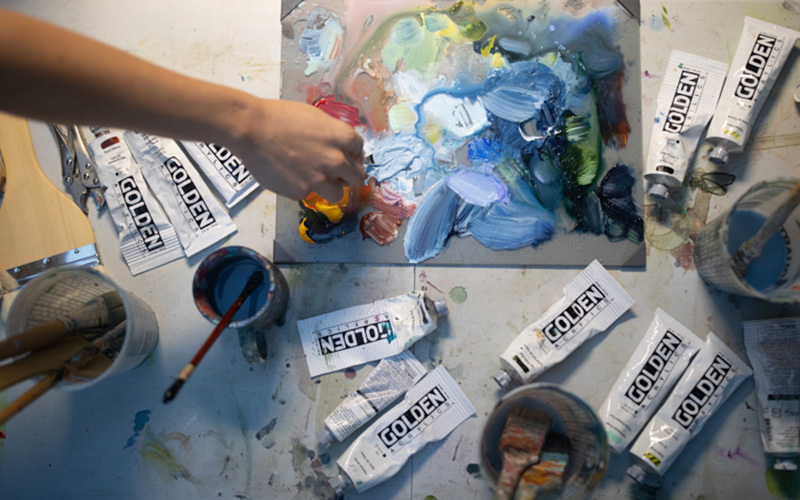 Having the right tools to support your art practice can make the difference between struggling and succeeding.
Having the right tools to support your art practice can make the difference between struggling and succeeding.
Three Pieces of Advice For Aspiring Artists
When Thomas thinks back to those early days of trying to find his way in the art world, he remembers how much he wanted the approval of others. But he realized that there was no way he would find the audience he sought if he didn’t feel worthy of that approval in the first place.
“My first piece of advice is to let people support you,” Thomas suggests today. “Let them buy a piece (for full price!), invite them to your events, bring them into the studio, and talk about your work.” If you want to be an artist, don’t be afraid to call yourself an artist, either: “I think being an artist is somewhat like being a realtor—every person you know should know that you are an artist and that you will sell them work.”
His second piece of advice is to get comfortable describing your work to strangers. The support of your close friends and family is absolutely vital for your self esteem, but you won’t know what’s really resonating with a wider audience until you talk about your work with people who aren’t already invested in it. “Integrate it into your small talk, run A/B testing on how different aspects land on new people—however it makes sense to you, just talk about it,” he suggests.
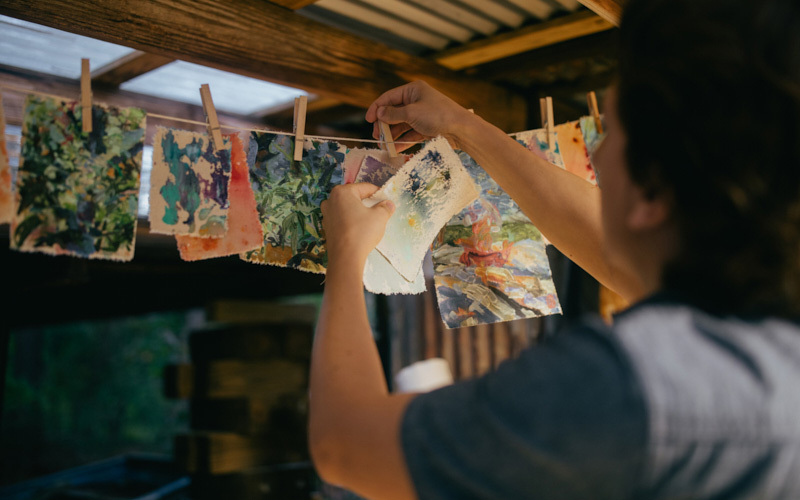 Thomas’s vision takes the form of paintings both big and small.
Thomas’s vision takes the form of paintings both big and small.
His third piece of advice is perhaps the most important: “make the damn work!” If you’re a painter, paint! If you’re a sculptor, you better be sculpting! “Fight for the studio time, because life will continue to happen whether you are in the studio or not,” he urges.
Thomas knows from experience that when you’re an artist, you have to prioritize your art. That doesn’t mean you have to neglect your family, or your health, or your sanity. Use tools like Artwork Archive to streamline your art business, and create a well-rounded schedule that leaves you energized and excited to get back into the studio.
According to Thomas, the stakes are just too high to let your art time be an afterthought. It can be easy to think of the time you spend in the studio as taking time away from the rest of your life—instead, think of it as enhancing and enriching it: “Be sure that you keep sacred studio time and allow things to happen in the studio—you might surprise yourself how deep the roots of your work will grow into your life.”
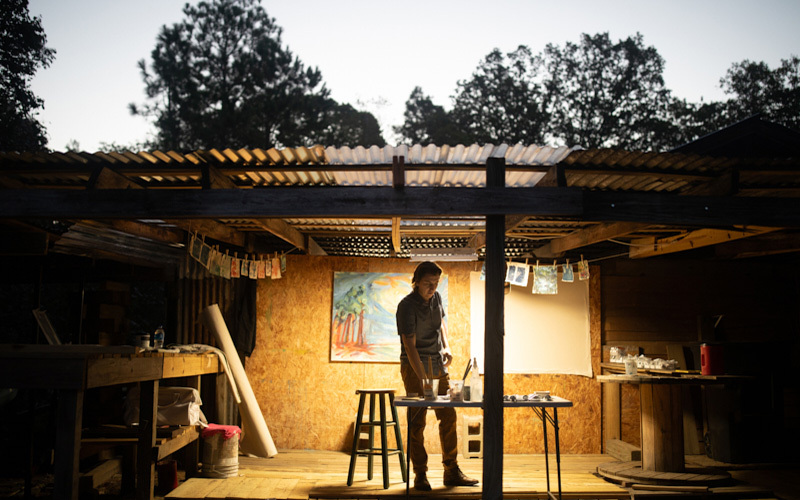 Take your art seriously—then watch the rest of the world follow suit.
Take your art seriously—then watch the rest of the world follow suit.
No matter where you are in your art journey, getting your business side in order doesn’t have to feel overwhelming. A bit of structure now can mean more time and headspace for the work you actually want to be doing.
Artwork Archive helps artists build an online portfolio, stay on top of their inventory, and create things like tear sheets and invoices in just a few clicks. Start a free trial and see how it fits into your own process.
